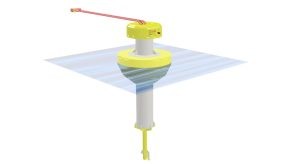A collaboration of UK green technology pioneers has been awarded a share of the Department for Transport and Innovate UK’s £60 million Clean Maritime Demonstration Competition (CMDC) grant funding to install the world’s first offshore charging station within a UK wind farm.
Project leaders Oasis Marine (specialists in marine charging solutions) have partnered with Turbo Power Systems (power electronics and rapid charging specialist), Verlume (an intelligent energy management and storage technologies specialist) and the Offshore Renewable Energy (ORE) Catapult (the UK’s leading technology innovation and research centre for offshore renewable energy) to deliver the world leading Offshore Charging Station. This smart energy storage and charging infrastructure will enable fully electric maritime operations within offshore wind farms.

During the two-year project, offshore charging infrastructure will be developed for charging hybrid and electric crew transfer vessels (CTVs) and will be demonstrated over two phases. The first will prove the transfer of power utilising Verlume’s battery and intelligent energy management technology, to charge a vessel via the Oasis Power Buoy while at sea. During the second phase the project will work with Vattenfall regarding technical and regulatory developments, aiming to lead to an on-turbine demonstration at their European Offshore Wind Deployment Centre (EOWDC) within Aberdeen Bay. AC power generated by the existing wind turbines will be supplied via Turbo Power Systems high power charging solution to the Oasis Power Buoy. During the demonstration a hybrid CTV would operate from Aberdeen Harbour to the wind farm, to then connect and recharge from the Oasis Power Buoy whilst waiting in field as maintenance technicians work on the turbines.
A major barrier for the decarbonisation of the maritime sector is the range and duration at which electric and hybrid vessels can operate. Currently vessels can only be charged within ports and most wind farms are too far from shore to allow journeys to be fully completed on battery power. Enabling offshore charging from a zero-emission energy source will allow CTVs to operate on electric power for the majority of the time, extending operational range and significantly reducing emissions. This breakthrough technology will enable full electric operation in the future.
George Smith, Managing Director at Oasis Marine said: “The ability to re-charge vessels offshore is crucial for decarbonising maritime. Initial sea trials of the Oasis Power Buoy were conducted in early 2022 and this CMDC funding allows for progression to full infrastructure testing. We are grateful to be working with valued project partners to ensure that comprehensive developments will be made. This technology promises to enable major carbon reductions and is a very encouraging development for the overall maritime industry to accelerate opportunities and confidence in electric and hybrid vessels.”
The infrastructure is building on the preceded development of Oasis Marine’s Power Buoy. Turbo Power Systems will design, build and test a high-power DC power supply for the conversion of power from the wind turbine to the charging unit. Verlume will utilise its energy storage expertise, supplying a modular battery energy storage system with integrated intelligent energy management to enable early testing and ORE Catapult will be responsible for CTV requirements, supporting a regulatory review and project management activities over this period. The project is supported by Vattenfall, operators of Aberdeen Bay Windfarm.
Carlos Neves, Chief Executive Officer at Turbo Power Systems (TPS) said:“This is a truly novel application for electric transport and a great opportunity for TPS to work with new industry partners and transfer our know-how in smart electric networks and robust electric vehicle charging offshore.
“Durability and accessibility of charging facilities is key to support wider electric vehicle uptake, whether that be car, bus or boat, on the road or at sea. With our proud history of designing and building power electronics that last in various challenging grid, industrial, aerospace and rail scenarios, we look forward to applying our engineering and manufacturing expertise to this exciting new environment for electric transport.”
Paul Slorach, Chief Technology Officer at Verlume said: “We are pleased to be part of this third phase of the Clean Maritime Demonstration Competition, it is a huge opportunity for Verlume and our project partners to demonstrate an innovative clean maritime solution which is capable of scaling across wind farms globally.
“The impact of the infrastructure is expected to be impressive, with a predicted minimum reduction of one tonne of carbon dioxide per CTV per day of operation over the life of the windfarm. We hope that this is the first step towards the vessel charging concept being a common sight in the offshore environment across the world.”
Håkan Borgström, Deputy Director, O&M Product Line at Vattenfall said: “The electrification of the vessels is an important requirement and the charging infrastructure an essential component. Vattenfall’s European Offshore Wind Deployment Centre at Aberdeen provides a great location for the demonstration of the Oasis Power Buoy and with our expertise we can support its implementation. For us is this an important step to decarbonise the logistics in the wind farm and part of our ongoing mission to deliver fossil-free living within a generation.”
Lauren Hadnum, Clean Maritime Manager at ORE Catapult, said: “Recharging in field is a critical enabler for the deployment of more electric support vessels. This project is an exciting step in demonstrating not only recharge at sea, but also integration with a working wind farm. We are pleased to be able to support this SME-led project to deliver an industry ready solution for CTVs by 2025.”
Crew transfer vessels will be the primary focus of the project, however the concept could also be scaled for oil and gas vessels, as well as larger service operations vessel (SOV) daughter craft which are considered an emerging vessel type set to increase in numbers rapidly as windfarms move farther from shore.













